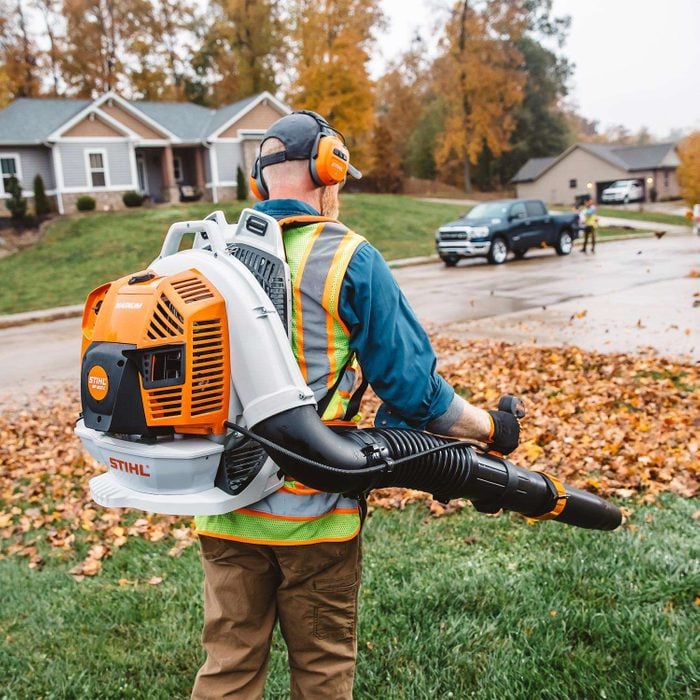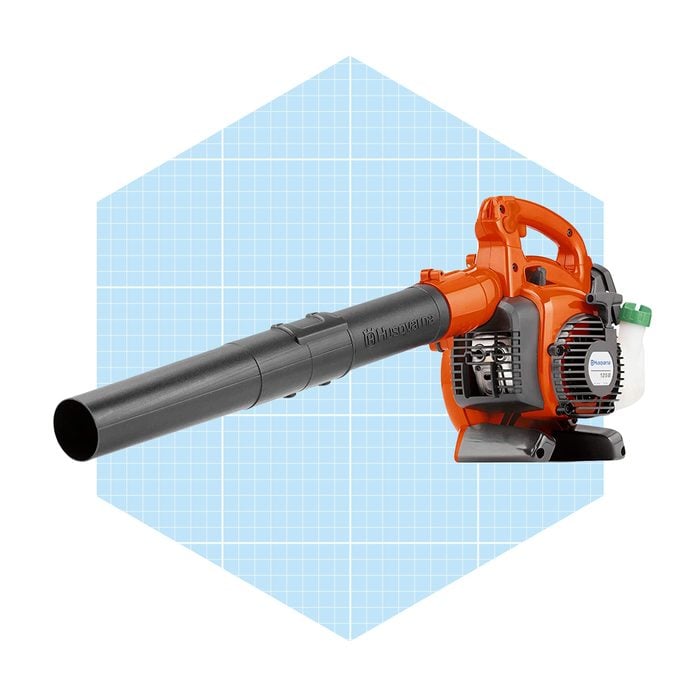
Best Overall Gas Leaf Blower
Husqvarna Two-Cycle Handheld Gas Leaf Blower
Buyers like the maneuverability, lightness and drying power of the Husqvarna two-cycle gas blower, giving it high marks on Amazon. It has an impressive high air volume of 470 cubic feet per minute (CFM) and velocity of 170 miles per hour (MPH) to make quick work of fall leaves. This best gas leaf blower features a stop switch that automatically resets to the “on” position for convenience. It offers cruise control, and the blowing tube length adjusts for the countless brilliant uses for your leaf blower.
“While I haven’t personally used the Husqvarna two-cycle gas blower, its specifications and reputation within the industry are noteworthy,” says Plant Bible chief editor and gardening expert, Zahid Adnan. “The powerful air volume and speed, coupled with Husqvarna’s dedication to ergonomic design and reduced noise levels, make it a promising choice for efficiently managing garden debris.”
Pros
- Features variable speed throttle with cruise control
- Adjustable tube length
- Weighs just 9.4 pounds
- Goes up to 170 MPH
Cons
- Doesn’t have an ergonomic handle
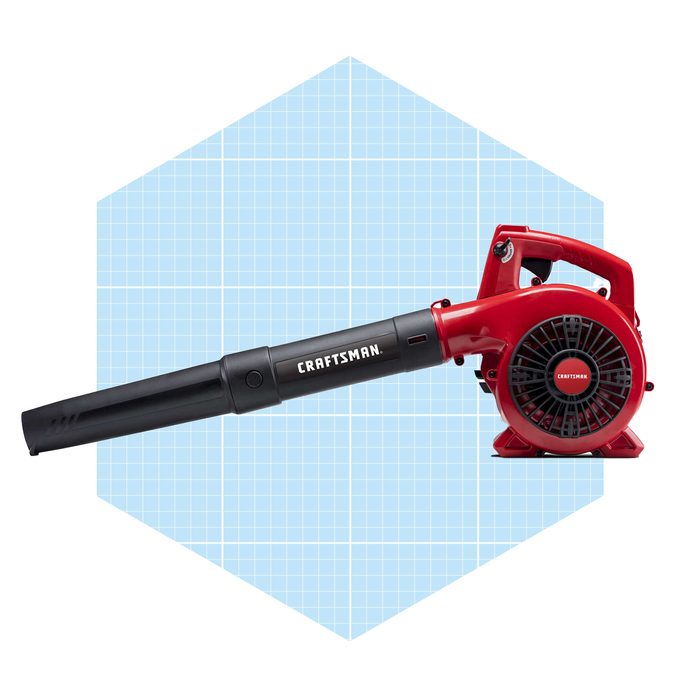
Best Budget Gas Leaf Blower
Craftsman Handheld Gas Leaf Blower
Make quick work of cleaning up smaller yards and gardens with the Craftsman handheld gas leaf blower. This pick has a two-cycle engine that provides 430 CFM and 200 MPH. It has user-friendly features, such as a lightweight design (just 10 pounds!) to reduce user fatigue, variable speed throttle for plenty of control and translucent gas tank, so you’ll know exactly how much gas you have left. Plus, the extended nozzle with an integrated scraper offers precise blowing to clear debris.
Pros
- Affordable price
- Features variable speed throttle
- Easy to assemble
- Fast and powerful
Cons
- Not ideal for large yards
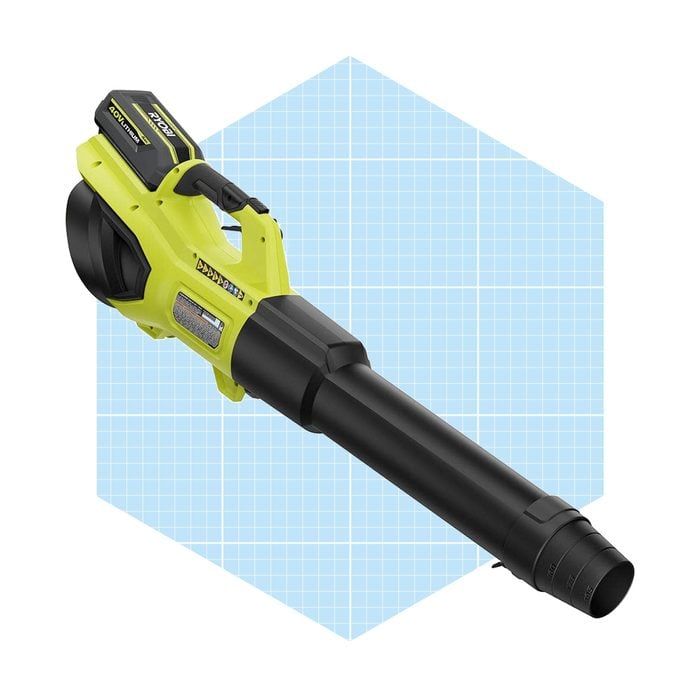
Best Low-Noise Gas Leaf Blower
Ryobi 40-Volt Whisper Series Cordless Leaf Blower
If you’re looking for the best gas leaf blower to clean up those fall leaves, and want a model known for being quieter than its competitors, check out the Ryobi 40V Whisper Series leaf blower.
The noise-dampening technology lowers the noise rating to 57 decibels (dB), which is 30 points lower than the industry standard and quieter than a dishwasher. Quiet as it is, it’s just as powerful as loud gas leaf blowers—it has a 730 CFM and can go up to 190 MPH, so it can tackle even the largest yards and most stubborn wet leaves. This unit has a runtime of up to 30 minutes, so you can take care of your front yard or backyard (or both!) in one shot.
Pros
- Has a noise rating of 57 dB
- Brushless motor is more durable than a traditional motor
- 730 CFM and 190 MPH
- Weighs less than 10 pounds
Cons
- On the pricier side
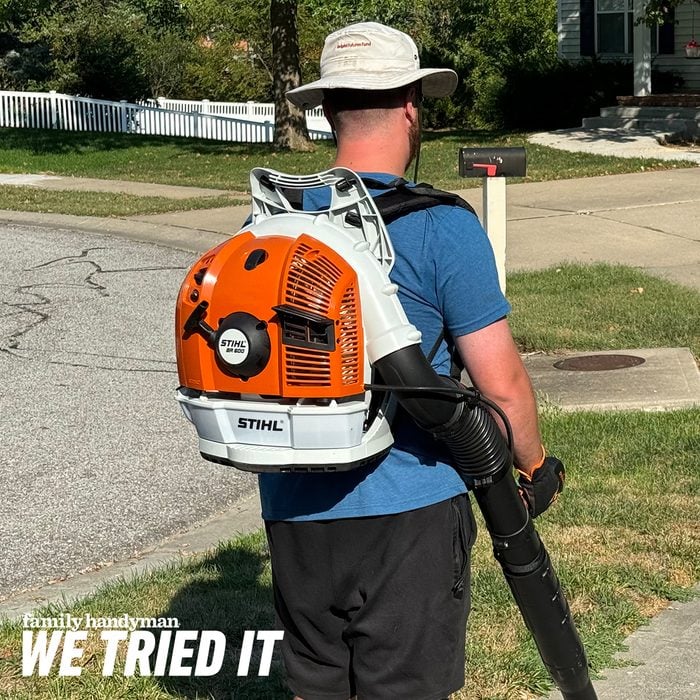
Best Backpack Gas Leaf Blower
Stihl BR 600 Backpack Gas Leaf Blower
If you’re looking for the best backpack gas leaf blower, the Stihl gas backpack leaf blower gets high marks for its ease of handling and maintainability. It has a fuel-efficient engine with plenty of power when it comes to air volume and velocity (677 CFM and 238 MPH, respectively). A quality choice for heavy-duty yard and garden cleanup, this model is comfortable with an adjustable harness, multi-function control handle and anti-vibration system. And at 22 pounds, it’s lighter than many other backpack gas leaf blowers.
“Good for large yards or clearing a lot of debris,” says professional landscaper Ralph Joed Abundo. Our shopping editor, Mary Henn, has tested it, too. “While the BR 600 is certainly an investment, it’s a worthwhile one if you do your own yard work and landscaping and like to keep things as tidy and pristine as possible,” she says.
Pros
- Has an adjustable harness
- 677 CFM and 238 MPH
- Designed to prevent operator from flooding the machine
- Three-position adjustable tube
Cons
- Expensive
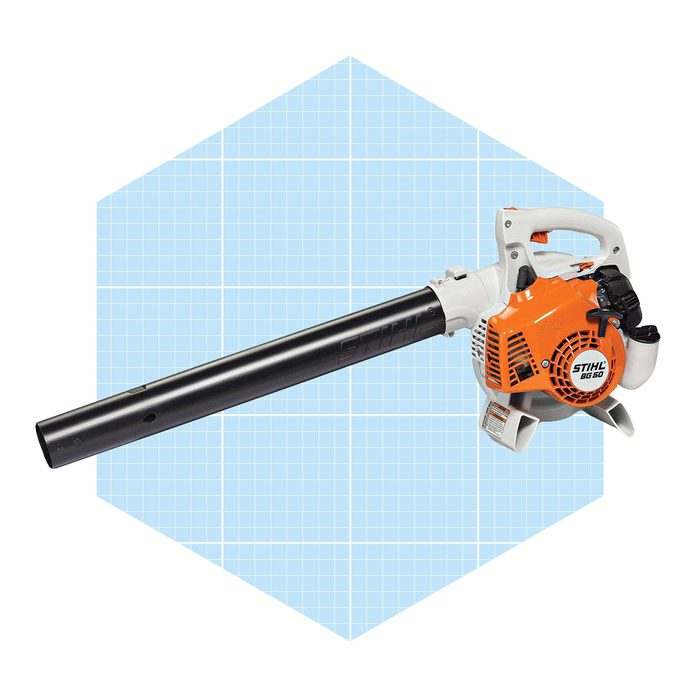
Best Lightweight Gas Leaf Blower
Stihl Handheld Gas Leaf Blower
You’ll get superior performance with the Stihl handheld gas leaf blower—without breaking the bank—making it a leaf blower not to be looked over. This handheld model is compact and lightweight at only 8 pounds, and has a surprising power-to-weight ratio of 412 CFM and 134 MPH. Let’s just say that a wet pile of leaves and brush won’t stand a chance. It also features a fuel-efficient, low-emission gasoline-powered engine, a solid choice for homeowners who want both quality and performance.
“Probably one of the best purchases I have ever made. This tool turned a very hard job into a much easier job. I could not recommend this leaf blower enough,” shares a verified buyer.
Pros
- Weighs just 8 pounds
- Won’t break the bank
- 412 CFM and 134 MPH
- Adjustable nozzle to work for various users
Cons
- Starts up with a pull cord

Best Splurge Gas Leaf Blower
Stihl Backpack Gas Blower with Electric Start
For those who find themselves dealing with a lot of leaves and aren’t afraid to shell out for the best gas leaf blower, you’ll want to take a look at the Stihl gas backpack blower with electric start. With a quick electric start, there’s no idling while walking across the yard to the next cleanup area or removing the unit to restart. Plus, it has powerful blowing power (642 CFM and 221 MPH) and a large fuel tank. All of this machine’s controls are on one handle, making it easy to operate.
Pros
- Hassle-free electric start
- 642 CFM and 221 MPH
- Adjustable tube length and control handle position
- Anti-vibration system
Cons
- Weighs 25 pounds
What to Look for When Buying a Gas Leaf Blower
With so many leaf blowers on the market, it can be hard to narrow down which one is best for you. You’ll want to consider things like noise levels, maintenance requirements and price ,but we reached out to more than 20 gardening experts to see what they look for in a gas leaf blower.
Power and efficiency: Most leaf blowers will advertise cubic feet per minute (CFM) and miles per hour (MPH) on their products. “CFM is a measurement of how much material a leaf blower can move. Basically, the higher the CFM, the more material it can move,” explains Sarah Jameson, gardening expert and founder of Lawn Chick. “If you get a thick layer of leaves in your yard, or typically have heavy rain during the fall, choose a blower with a higher CFM.”
“[MPH] measures the speed at which air is pushed through the blower’s nozzle and is directly related to the speed at which you can clear leaves from your yard,” Jameson continues. “Homeowners with a large yard should choose a blower with a higher MPH rating. A blower with high MPH is great for large yards that get a lighter coating of leaves to clear.”
Weight and ergonomics: “Look for features like adjustable tube lengths, soft-grip handles and a balanced design,” says Aaron Green, owner at Essential Home & Garden. “Long term, your back will thank you.” Additionally, look for a weight that you can realistically hold for long periods of time without any discomfort.
Starting mechanism: “Check if the blower features a reliable and user-friendly starting mechanism, such as a primer bulb or a choke. Quick and hassle-free starting can save time and frustration,” says horticulturist and landscape designer, Jack Hall.
Fuel efficiency: “Look for models with adjustable throttle settings to match the power output to the task at hand,” Hall says. There are two types of engines: two-cycle and four-cycle. A four-cycle engine uses fuel in a more cost-efficient way than a two-cycle, but a two-cycle should work for most small and mid-sized yards.
Types of Leaf Blowers
- Handheld leaf blowers: As the most common choice, they’re suited for smaller lawns and are available in gas, electric and corded models.
- Backpack leaf blowers: These come with straps to wear on your back. Backpack leaf blowers are a smart option if you have more area to over, such as an acre or more. They’re available in gas and electric.
- Walk-behind leaf blowers: These are more of a specialist machine, many of which are commercial models. They’re ideal for large, flat yards with a lot of leaves.
Why You Should Trust Us
Since 1951, Family Handyman has been covering the home space and providing trusted reviews on the best products. And as a shopping writer and editor, I carefully research the product at hand and dive into real-world customer feedback to help steer your shopping decisions in the right direction.
How We Found the Best Gas Leaf Blowers
Our search for the best gas leaf blower began with reaching out to dozens of gardening experts for this piece, and looking at our leaf blower buying guide to find out what separates a great gas leaf blower from a bad one.
“While many blowers can boast high airspeed or power, the best ones ensure that this power doesn’t come at the cost of user comfort,” says Gene Gaballero, who has more than 25 years in the landscaping industry and founded GreenPal, a service that can locate lawn care companies in your area. “When investing in such equipment, remember it’s not just about the specifications but also about the tool’s real-world performance, longevity and how comfortable and efficient it makes your work.”
In other words, we had to look for gas leaf blowers that didn’t just have a powerful engine, powerful airspeed and great fuel efficiency, we had to find ones that people liked using.
We researched more than 36 gas leaf blowers on the market and dug into the customer reviews of more than 20 before picking our top six and running them through our expert gardeners.
FAQ
What is the most reliable leaf blower brand?
We spoke to more than 20 gardening experts, and they agreed that Husqvarna is the most reliable leaf blower brand.
How many CFM should a good leaf blower have?
A gas leaf blower for a small yard should be able to move at least 200 to 400 CFM, and a mid-sized yard with more leaves should have 400 to 700 CFM.
What is more important for a leaf blower: CFM or MPH?
People who need to move a lot of material, or get a lot of rain on top of their leaves, should look for a higher CFM. Homeowners with larger yards should look for a leaf blower with more MPH, because it can help them get the job done in a shorter amount of time.
Sources:
- Zahid Adnan, Plant Bible chief editor and gardening expert
- Ralph Joed Abundo, a professional landscaper
- Sarah Jameson, a gardening expert and founder of Lawn Chick
- Aaron Green, owner at Essential Home & Garden
- Jack Hall, a horticulturist and landscape designer
- Gene Gaballero, founder of GreenPal

